Contents
Different types of lamps are used to illuminate seedlings, but not all of them are equally useful. Plants grow well under red and blue light spectrum. Light temperature is also important to consider. Factory-made and home-made LED lamps for seedlings help to create optimal lighting conditions.
Spectra and color temperature
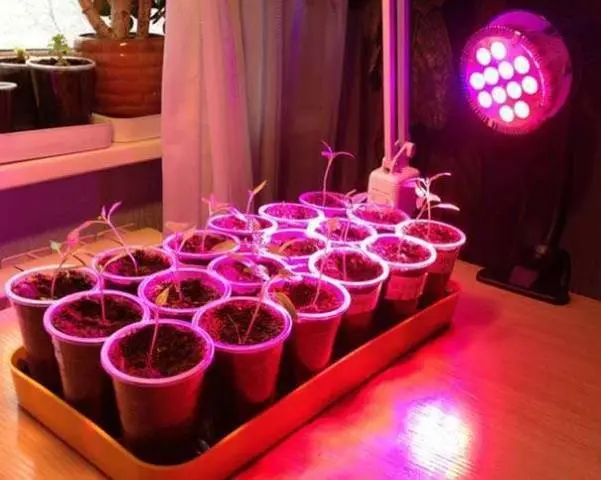
When choosing a suitable LED lamp for illuminating seedlings, you need to find out what spectra and color temperature it emits. Plants will benefit from:
- Blue glow has a positive effect on cell development. The optimum color temperature is 6400 K.
- The red glow stimulates seedlings and the development of the root system. The optimum color temperature is 2700 K.
Plants are susceptible to light – 8 thousand lux. It is difficult to achieve such indicators with artificial light sources. If the seedlings are illuminated with LEDs, then the illumination is about 6 thousand lux.
The duration of additional illumination for each culture is different. When choosing LED lighting for seedlings, the operating mode can be set with the following time limit: after germination, cabbage and tomato seedlings are illuminated for 16 hours, seedlings of adult tomatoes – 14 hours, cucumbers – 15 hours, peppers – 10 hours.
Novice vegetable growers are interested in the question of whether seedlings can be illuminated with white LEDs if there are no specialized lamps. The fact is that the peak of the blue and red spectrum, necessary for plant photosynthesis, is 440 and 660 nm. White LEDs are characterized by a wide emission spectrum, but their peaks do not correspond to the norm. On the other hand, planting material develops well under fluorescent fluorescent lamps. This means that white simple LED lamps for illuminating seedlings are also suitable.
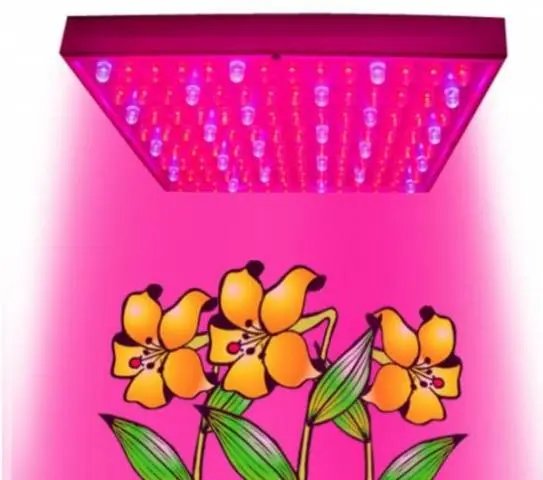
The height of its location above the planting material depends on the power of the LED lamp. Some cultures like strong brightness, others moderate. It is optimal to maintain a gap between plants and a lamp – from 10 to 50 cm.
The video provides an overview of LED backlight lamps:
The advantage of LED light sources
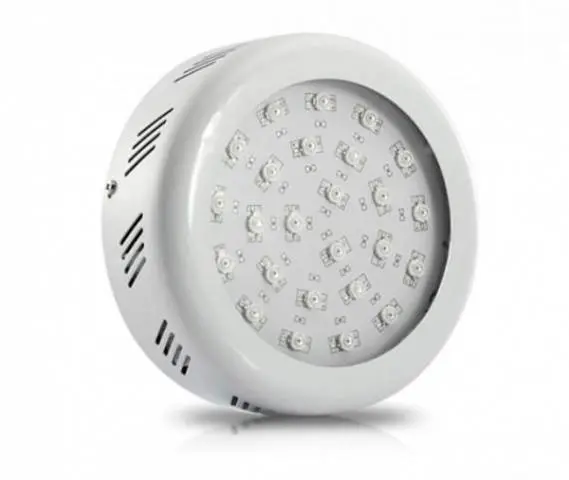
In addition to saving energy, self-made seedling lighting with LED lamps is characterized by the following advantages:
- Long service life. LEDs are able to shine up to 50 thousand hours, subject to proper arrangement of heat dissipation.
- A burnt-out LED is easy to replace on your own in a home-made lighting device. Repair will be much cheaper than buying a new lamp.
- LEDs can be selected according to the temperature and color of the glow, which allows you to create optimal lighting for each group of planting material.
- A smooth change in the brightness of the glow with a dimmer brings artificial lighting closer to natural light.
- Low heat generation will allow you to bring the LED lamp as close as possible to the seedlings without the risk of burns.
- LEDs do not contain mercury and other harmful substances.
- The lamp works with a voltage of 12 or 24 volts, which creates the safety of the grower’s care of planting material.
The disadvantage is still the high cost of high-quality LEDs, but in 2-3 years the backlight will pay for itself.
Varieties of lamps
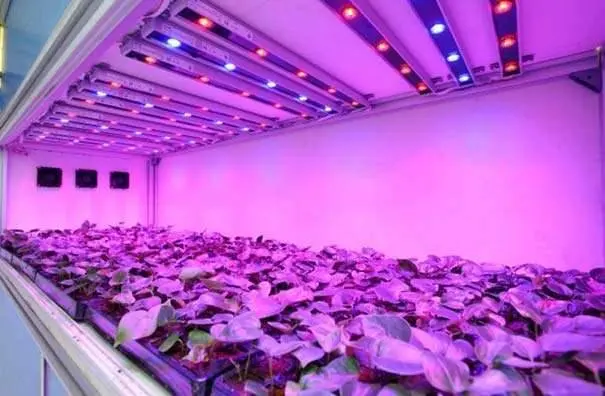
LED lighting devices are produced in different sizes and shapes. Depending on the amount of planting material, the luminaires can be completed or independently assembled from LEDs according to individual parameters. When choosing devices according to the form, they are guided by the following parameters:
- Tubular models are convenient for arranging lighting on long narrow shelves or window sills.
- Tablets or panels in the form of a square cover a large area. The luminaire is suitable for illuminating wide shelves.
- A single low-power lamp is used when growing a small amount of seedlings.
- Spotlights illuminate a wide area with a large amount of planting material.
- LED strips allow you to organize the backlight with a lamp of arbitrary shape.
The price of LED lamps for seedlings is formed according to the quality and characteristics of the LEDs. It is necessary to give preference not to cheap lamps, but to those that are more suitable for growing planting material.
Assembling a homemade lamp
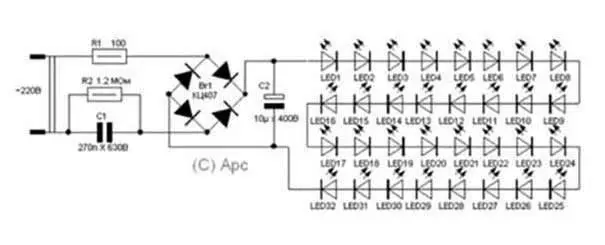
Homemade LED lamps for illuminating seedlings can be soldered from individual light bulbs. The presented circuit in the photo consists of LEDs and a rectifier power supply. The complexity of the assembly lies in the large number of parts to be soldered.
It is easier to assemble the lamp from an LED strip and an old fluorescent lamp housing:
- First, all the stuffing is removed from the inside, and instead an aluminum plate is installed – a cooler.
- LED strips of blue and red glow are cut into segments in one module. The cut points are marked with a scissors pattern.
- Each module is soldered with wires, alternating colors. Red light bulbs usually go 5-8 times more than blue light LEDs.
- The coolant is degreased with alcohol. On the back side of the self-soldered LED strip, the protective film is removed and glued to the aluminum strip.
- The tape is connected to a 12 or 24 volt power supply, which depends on the characteristics of the product. If the lamp glows normally, a native matte diffuser is placed on the body.
It is even easier to assemble the lamp from LED phyto tape. The light bulbs are already selected on a tape of different glow colors, which will save you from the laborious process of separating and soldering the modules.
The video shows the LED lamp for illumination:
Tips for choosing LED light sources
Useful tips will help you figure out which LED lamps for seedlings are better.
Form
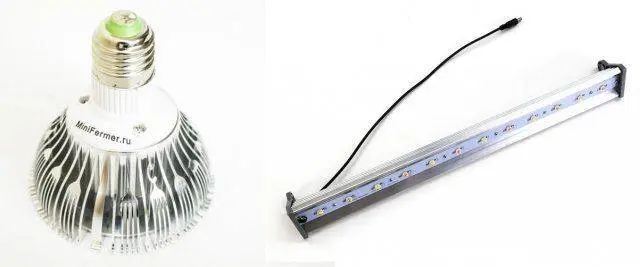
Long shelves or a window sill are best illuminated with a linear lamp. Round plinth models are suitable for illuminating free-standing seedling boxes. The lamps create a limited projection of the light spot, and in long sections you will have to hang several of them.
Spectrum of LEDs
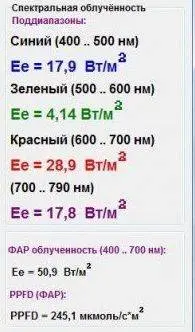
Red and blue glow is useful for the development of seedlings, but if the wavelength does not match, there will be little benefit from the phytolamp. When buying a product, it is important to study the spectrogram on the packaging. The optimal blue wavelength is 450 nm, and the red wavelength is 650 nm. If the parameters deviate or there is no spectrogram, it is better to refuse to buy a phytolamp.
Power

When calculating the power of LED lamps for seedlings, it is necessary to distinguish between two important parameters:
- rated power indicates the limiting parameter of the LED;
- real power is how much the LED will actually give out.
Light bulbs cannot be constantly operated at rated power, otherwise they will quickly fail. It is customary to apply voltage by half. If we take a 3 W LED, then its real power will be 1,5 W.
The total power of the lamp is calculated by the number of LEDs. Moreover, it is the real, and not the rated, power that is summed up.
Radiator
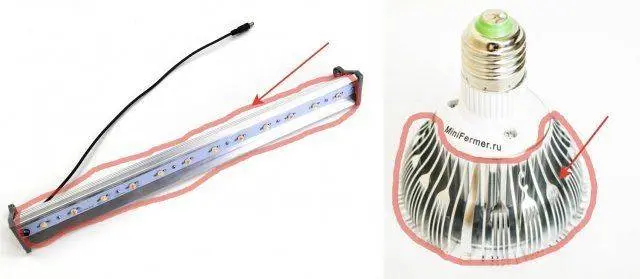
LEDs emit little heat, but they do get warm. Radiators are aluminum coolers that prevent the crystals from overheating above the allowable temperature of 75оC. In case of overheating, the LED changes its parameters or fails. A small radiator is unable to remove heat from a large number of light bulbs.
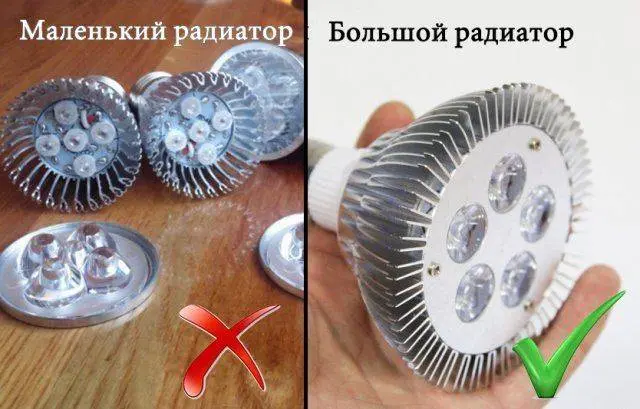
The greater the distance between the LEDs, the better. The radiator copes with its functions faster.
The gap between the phytolamp and the tops of the plants
Phytolamp power | seedling distance | Light spot projection (diameter) |
7-10 W | 20-30 see | 25-30 see |
7-10 W | 35-40 see | 45-50 see |
15-20 W | 40-45 see | 85-90 see |
When seedlings are illuminated with LED lamps, it is important to correctly calculate the distance between the tops of the plants and the light source. The gap range is usually from 10 to 50 cm. Considering the power of the phytolamp, the diameter of the light spot and the characteristics of the growing vegetation, the optimal distance is calculated.
Phytolamp Spectra
In order for LED lighting of seedlings to be beneficial, you need to choose the right phytolamp. Depending on the composition of the spectrum, the light source is divided into three groups:
- bicolor lamps emit blue and red light. The phytolamp is suitable for illuminating seedlings in standard growing on racks or a windowsill.
- A “full spectrum” lamp displays its characteristics in the name. A product of universal purpose, the glow of which, in terms of parameters, is close to the sun’s rays.
- In the “multispectrum” lamp, a white glow and another distant red color are added to the two primary colors. The light source is used to illuminate adult plants indoors.
When buying LED lamps, you should give preference to branded products with a guarantee. In case of failure, the seller is obliged to replace the goods.
Reviews
About LED lamps for seedlings, reviews are of a different nature. Let’s take a look at a few of them.









